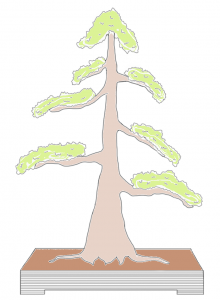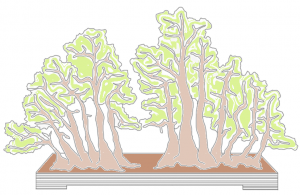The natural conditions where trees grow are very different. Some have almost ideal conditions for development: sufficient light, the right amount of water and nutrients, and free space for normal canopy development. Other plants, however, lack such “luxuries”. Some grow on steep cliff faces, and as a result, their roots seek places to firmly “cling” to the rock. Others grow in soil that lacks sufficient water or nutrients, some don't get enough sunlight, and some are tilted to one side due to prevailing winds. Trees in nature often need to fight for survival under unfavorable conditions. All of this greatly influences the plant’s development. As a result, trees grown in different environments have different forms and sizes of canopies, trunks, and roots. This variety of forms in nature became the basis for the formation of certain “standard” styles in bonsai culture. Of course, it is difficult to fit the shape of trees grown in nature into a certain framework, but in Japan, a certain system of bonsai forms was created, bonsai styles, with appropriate Japanese terminology, which bonsai enthusiasts and professionals around the world use.
Absolutely Straight Trunk. Chokanni (直幹)

The tree trunk is straight, without any tilting. The canopy should have a conical shape. The tree’s apex and base are aligned in a vertical line. The branches do not grow in the lower 1/3 of the entire height. The surface roots are spread in all directions.
Trunk with Bends at One or Several Points. Moigi (模様木)

The tree trunk is twisted and bent. As in the Chokkan style, the surface roots are well-developed and spread in all directions. Despite the twisted and bent form of the trunk, the tree’s apex and base are aligned in a vertical line. The branches do not grow in the lower 1/3 of the entire height.
Straight or Curved Trunk, Tilted to One Side. Shakani (斜幹)

The tree trunk is tilted at 60-70 degrees from the surface. The first lower branch should be on the opposite side of the tilt. The tree trunk can be straight or slightly bent in several places.
Zigzag Trunk. Bankani (蟠幹)

In the Bankan style, the tree trunk has a zigzag shape, similar to the Latin letter "S." The main branches grow outward from the point where the trunk bends, while the top and base of the tree are aligned on the same vertical line.
Double Trunk. Siokani (双幹)

The branching starts from a common root. Two trunks of different sizes, both in thickness and height. The thicker, more developed trunk is taller. Both trunks should form a single canopy and have the shape of one unified tree.
Cascade: A tree "hanging" in one direction. Kengai (懸崖)

This style of bonsai resembles a tree growing on a steep cliff slope. The roots are deeply embedded in the soil, and the branches hang over the cliff. The upper part of the canopy remains above the surface of the container. The main part tilts downward in a zigzag shape. The end of the tree's canopy must be below the level of the container's surface, and in many cases, the end even extends past the bottom of the container. Bonsais of this style are placed on special high stands.
Half Cascade: Han-Kengai (半懸崖)

In the case of the Han-Kengai style, the end of the canopy should be at the level of the container's surface or slightly below it. Trees of this shape are often found on cliffs, or along the steep shores of rivers and lakes. The plant grows slightly upward in height, while one or several branches tilt downward.
Hoop-like Style. Hokidachi (箒立ち)

This style is suitable only for deciduous trees. The lower 1/3 of the tree's height has no branches. The lower, branchless part of the trunk is absolutely straight. The tree has no top. The branches are fine and very dense, growing in all directions. There is no distinctly prominent branch, and all of them have roughly equal thickness. The canopy has a hemispherical shape.
Multiple Trunks: Kabudachi (株立)

Near the roots, the trunk starts to split. Although this style of bonsai has multiple trunks, its canopy should resemble the form of a single, whole tree. Theoretically, this style is the same as "sho-kan," but the number of trunks must be 3 or more.
Wind-Swept Tree: Fukinagachi (吹き流し)

The tree's trunk is slightly tilted to one side, and the branches grow in only one direction, in the direction in which the trunk is leaning. One should imagine a strong wind blowing, causing the tree to lean in the direction of the wind. Forming a bonsai in this style requires considerable imagination and experience from the enthusiast.
Literati Style: Bunzingi (文人木)

This style is only suitable for coniferous plants. It features an elegantly bent high trunk. The formation of the canopy occurs only in the upper part of the plant. The liturgical style bonsai has a very specific form. Its true evaluation can only be made by those who deeply understand what bonsai is.
The idea behind the style is to create a plant that shows it grew in unfavorable environmental conditions and required a great deal of effort to survive.
Group of Trees with a Common Root. Netsunagari (根連なり)

In the case of the netsunagari style, the trees grow from a common root. In this style, the trunk of the tree must be in odd numbers, such as 3, 5, 7... The trees are arranged almost in a straight line. The largest trunk should be the tallest.
Tree Planted in the Ground. Ikadabuki (筏吹き)

The tree, which has all of its branches cut off on one side, is buried horizontally in the ground, so that its trunk appears above the soil surface as a single root. The largest and most developed branch is the tallest.
Forest. Yose ue (寄せ植え)

Yose ue style is a miniature model of a forest. A group of such trees can be found in any climatic zone.This style of bonsai has its advantages. When creating Yose ue, 2-3 year-old saplings can be used. For beginner enthusiasts who are eager to see the results of their work, this style can be a good starting point. Even saplings with poorly developed branches can be used, as the flaws in the branches of other trees in the group can easily cover them.
It is advisable to select trees of the same species, with small leaves or needles. Of course, a "mixed forest" can also be created. However, in this case, it will be necessary to choose species that have the same growth rate and approximately similar leaf sizes. Due to the miniature size, contrasting differences in leaf size make this style less attractive. A combination of coniferous and deciduous trees will also not work.It is also important to consider the number of saplings. For creating Yose ue, an odd number of plants is preferred.
Composition on Stone. Ishitsuki (石付) and Sekiziejū (石上樹)


Isitsuki is an imitation of a tree grown on a rock. In this style, two categories can be distinguished: Isitsuki — the tree's roots grow entirely into the stone, and Sekijyū — the tree's roots are wrapped around the surface of the stone. Like all styles, the composition on the stone should also look natural. When choosing a plant, keep in mind that the first branch should be close to the roots. In other styles, the distance of the lower branch from the roots is one-third of the plant's height, but in Isitsuki and Sekijyū styles, this space should be filled by the stone. The proportional relationship between the stone and the plant is entirely up to the creator's taste. To fully understand this style, it is best to carefully observe examples created by experienced bonsai specialists. The stone should have holes, scars, and indentations, showing that natural forces have had a significant impact on its "formation." The stone chosen for this style should resemble a rock in some way. Gravel or artificially processed, smooth-surfaced stones are not suitable for this bonsai style.
Miniature Landscape. Saikei (栽景)
Saikei is the creation of a miniature landscape using stones, soil, water, herbaceous plants, moss, and small trees. Saikei should create an illusion of miniature nature, with all elements harmoniously combined. Each component should be placed in the container in such a way that all proportions are maintained, and the composition looks natural.
The soil, stones, and plants are arranged to create a natural model of a seaside, hilly meadow, or mountainous landscape. The trees themselves are similar to those of classic bonsai. In addition to the trees, various herbaceous plants are also used, which enhances the illusion of a natural landscape. Saikei allows for a freer selection of trees, and even very small, 2-3 year-old saplings can be used.
For a miniature landscape, small or medium-sized trees can be used, both deciduous and coniferous. Fruit-bearing trees are generally not used in this case, and the number of trees is entirely dependent on the creator's taste. Unlike miniature forests, an even number of trees is allowed. A beautiful saikei can be made from a single tree. Both single and different species of trees can be chosen.
Thank you to Salome Lashkhi for creating the bonsai illustrations.

